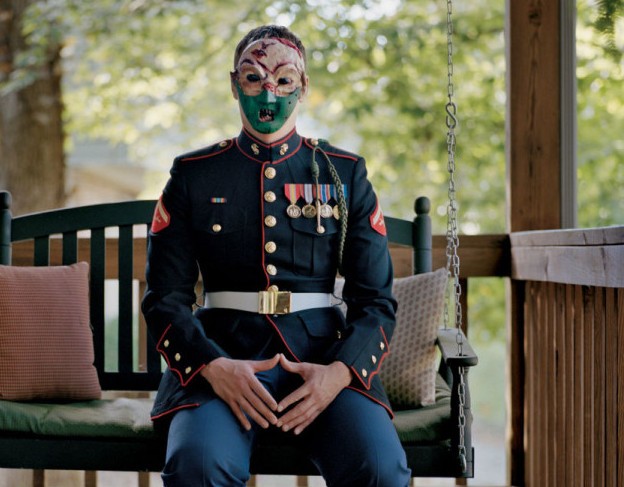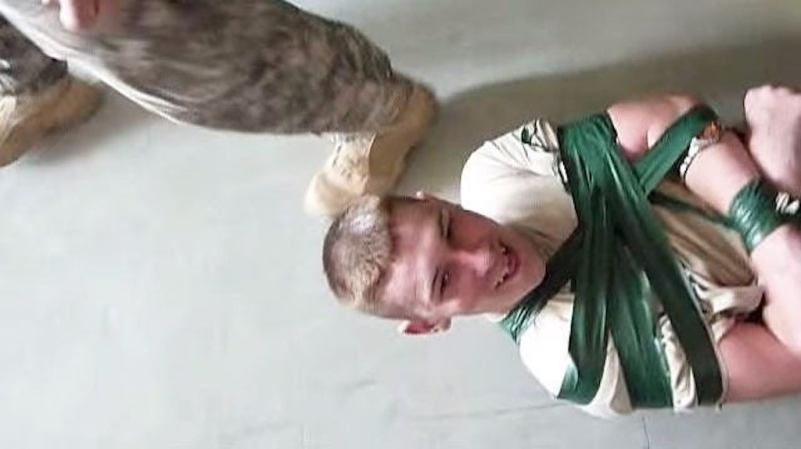The cover story of National Geographic magazine’s February issue, “The Invisible War on the Brain,” takes a close look at a signature injury of the Afghanistan and Iraq Wars—traumatic brain injuries (TBIs) caused by the shock waves from explosions. TBIs have left hundreds of thousands of U.S. veterans with life-altering and sometimes debilitating conditions, the treatment of which can be extremely complicated. At Walter Reed Medical Center in Bethesda, Maryland, soldiers paint masks that help them cope with their daily struggles and help them reveal their inner feelings. We invite you to see the service members’ masks and read the full story here.
Impeccable in his Marine uniform and outwardly composed, McNair sits on the porch of his parents’ home in Virginia, anonymous behind a mask he made in an art therapy session. “I was just going through pictures, and I saw the mask of Hannibal Lecter, and I thought, ‘That’s who I am’ … He’s probably dangerous, and that’s who I felt I was. I had this muzzle on with all these wounds, and I couldn’t tell anyone about them. I couldn’t express my feelings.”

Marine Cpl. Chris McNair (Ret.), Afghanistan 2011-12. (Photo by © Lynn Johnson/National Geographic)
Wearing his mask—half patriotic, half death’s-head—Hopman confronts the battery of medications he takes daily for blast-force injuries he sustained while treating soldiers as a flight medic. “I know my name, but I don’t know the man who used to back up that name … I never thought I would have to set a reminder to take a shower, you know. I’m 39 years old. I’ve got to set a reminder to take medicine, set a reminder to do anything… My daughter, she’s only four, so this is the only dad she’s ever known, whereas my son knew me before.”

Army Staff Sgt. Perry Hopman, Iraq 2006-08. (Photo by © Lynn Johnson/National Geographic)
“Detonation happened, and I was right there in the blast seat. I got blown up. And all this medical study—nobody ever thought that they [blast events] were very harmful, and so we didn’t log them, which we should because all blast forces are cumulative to the body. On a grade number for me, it would probably be 300-plus explosions … I’m not going to not play with my children. I’m not going to let my injuries stop them from having a good life.”

Marine Gunnery Sgt. Aaron Tam (Ret.), Iraq 2004-05, 2007-08, (with wife Angela and their two children). (Photo by © Lynn Johnson/National Geographic)
Tiffany H., as she prefers to be known, was “blown up” while helping women in a remote Afghan village earn additional income for their families. Memory loss, balance difficulties, and anxiety are among her many symptoms. The blinded eye and sealed lips on her mask.

Marine Gunnery Sgt. Tiffany H., Iraq 2007-08, Afghanistan 2010-11. (Photo by © Lynn Johnson/National Geographic)
Suiting up before attempting ordnance disposal “is the last line. There’s no one else to call … It’s the person and the IED … and if a mistake is made at that point, then death is almost certain. They call it the long walk because once you get that bomb suit on, number one, everything is harder when you’re wearing that 100 pounds … Two, the stress of knowing what you’re about to do. And three, it’s quiet, and it seems like it takes an hour to walk.”

Air Force Staff Sgt. Robert “Bo” Wester (Ret.), Iraq 2007, 2008-09, Afghanistan 2010. (Photo by © Lynn Johnson/National Geographic)
Brain injuries caused by blast events change soldiers in ways many can’t articulate. Some use art therapy, creating painted masks to express how they feel. (Photos by © Rebecca Hale /National Geographic)
















